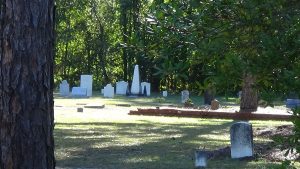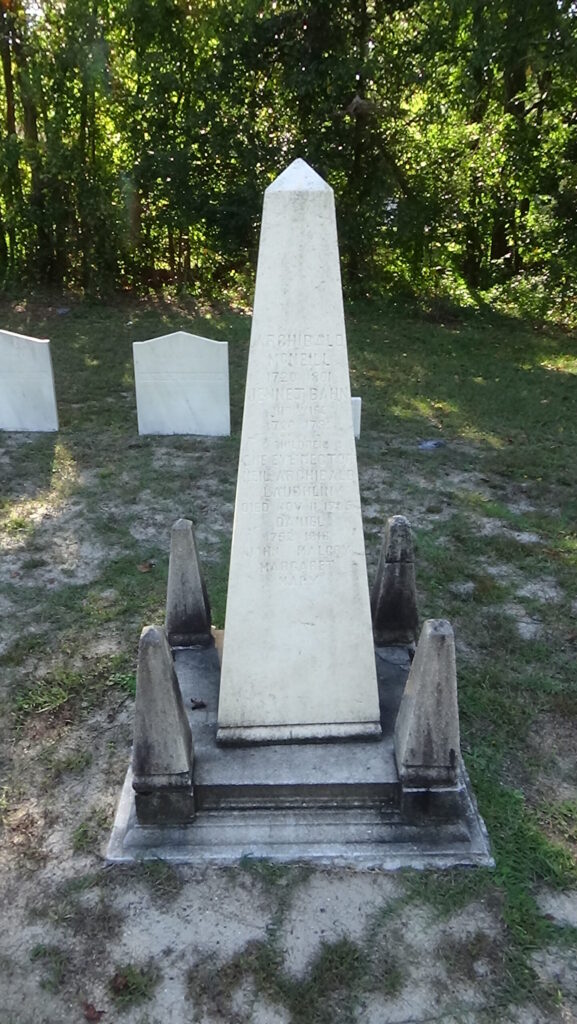A Revolutionary Wrangler
Location
Other maps: Bing, Google, MapQuest.
Coordinates: 35.1926, -78.9866.
Type: Stop
Tour: Tory War
County: Cumberland
![]() Full
Full
Drive to the back-left corner of the parking lot at the Church of the Covenant. To find the grave marker, look toward the back edge of the cemetery—to your left if facing the church—for what looks like a model of the Washington Monument. Though visible from a distance, a relatively easy stroll takes you to the resting site of a remarkable woman and her remarkable marker.

Description

 If Janet Smith McNeill had lived in the Wild West a hundred years later, she would have been a famous “cowgirl,” as they were called at that time! She and her husband Archibald may have been the biggest cattle ranchers in America before the war.
If Janet Smith McNeill had lived in the Wild West a hundred years later, she would have been a famous “cowgirl,” as they were called at that time! She and her husband Archibald may have been the biggest cattle ranchers in America before the war.
She was the child of lowland Scots. Nothing is known of her childhood until the family emigrated in 1739, when she was about 19. Her mother died on the voyage. Her father settled them in today’s Harnett County (northeast of Fayetteville), but died five years later. Achibald, whom she married in 1748, was easygoing, known as “Archie Scrubblin’”—slang for “insignificant,” according to a Harnett history book. But he signed a 1757 petition against the court justices running Cumberland County, which included modern Harnett then. It said “they have always opposed every good measure and endeavored to turn everything to their own privat (sic) advantage…” which sounds like the complaints of famous protestors called the Regulators ten years later.[1]
Given Archie’s reputation, it is not surprising that Jennie appears to have done most of the work in that family. She claimed large tracts of land with a surveying method neighbors did not appreciate: by making an enslaved person walk until she “rang a large bell. At the sound of the bell he was to travel another direction,” and so forth until he had marked off the land. This led to multiple lawsuits that were still in play when her son inherited the claims.[2]
She would sometimes lead cattle drives on her own, taking as many as 1,500 head to the nearest markets in Petersburg, Va. Tax records only list 500 head owned by the McNeills, but she may have been driving others’ animals under contract.[3]
McNeill was a hard-nosed business person. When one Virginia farmer refused to sell grain for her herd, she had her ranch hands tear down his fences so the cattle could feed themselves. No doubt the man underestimated the petite, fair-skinned redhead nicknamed Jennie “Bahn” (Gaelic for “the Fair”) by her neighbors.
At some point she visited Philadelphia and met Benjamin Franklin. He so impressed her that his name was given to children for multiple generations in her family. Yet when the war broke out, she officially declared herself neutral—for business reasons. This may seem unusual, but historians estimate there were as many “neutrals” during the war as there were Patriots or backers of the king. (Archibald’s choice in that decision, if Jennie gave him one, is unrecorded.)
Families often split their loyalties, and hers was no exception. They had seven sons, one of whom died young, and two daughters. Five sons were Loyalists, including “Leather-Eye Hector McNeill,” also called “One Eye,” to differentiate him from another Tory colonel with the same name. He lost the eye in a fight with his future father-in-law, who hated him and lost the tip of his nose in the bargain. The sixth son served briefly in the Patriot militia and was the Cumberland County sheriff.[4]
Jennie visited William Sprowl after a 1781 Loyalist raid on his ferry over the Cape Fear River, in which one man was killed and Sprowl and his wife were abused. He was thinking of returning home to Scotland or moving to Philadelphia, where his brother lived. With both in tears, she talked him into an option to buy the ferry at a discounted price. She bought the land, it became McNeill’s Ferry, and shortly after Sprowl was murdered.[5]
During the war the McNeills lived on Anderson Creek, east along the Little River that passes north of the cemetery (to your right when facing the monument). On its retreat to Wilmington to recover from the Battle of Guilford Court House, the British army of Lt. Gen. Lord Charles Cornwallis camped on the McNeills’ plantation.[6] One source says British foragers came to the house and grabbed her riding horse. Jennie went out to say goodbye, supposedly. She rubbed her neck—then pushed off the bridle, spooked her with the reins, and said, “Git, you beast!” The horse ran.
Jennie told the British, “Catch her if you can.” They couldn’t.[7]
After the war Jennie and Archibald moved about six miles east of here. Despite her death in 1791 at 71, there was yet another chapter to be written about her.[8]
Monumental Bad Luck
 This stone obelisk from Scotland marks the grave of Jennie and Archibald. Even the stone has a story.
This stone obelisk from Scotland marks the grave of Jennie and Archibald. Even the stone has a story.
The McNeills’ sons had the column and a base imported from Scotland to Wilmington and then floated up the Cape Fear River to Fayetteville. As the pieces were being unloaded, the base toppled over the side of the barge, and for years lay on the river bottom. The obelisk was brought to the family graveyard on a bluff overlooking the river. For years it laid there on its side.
The base was eventually recovered and stored temporarily in a building at a stoneyard. But the building caught fire as the base was being prepared, and it dropped into the basement. Apparently too difficult to retrieve from the rubble, over time the base and the site were covered over and lost. Not until the 1920s did a descendant have a new base made, and the obelisk was finally raised and inscribed.
However, its saga was not yet over! Years later the mining company Martin Marietta leased the land that was the McNeill homesite to build a quarry. It obtained permission under state law to move the family graves here. The traveling monument made (hopefully) one last move in 2008.[9]
[1] Fowler, Malcolm, They Passed This Way: A Personal Narrative of Harnett County History (Harnett County Centennial, Inc., 1955) <https://digital.lib.ecu.edu/17023> [accessed 3 August 2022]; emigration date and other information repeated on: Exhibits, Scottish Heritage Center, Laurinburg, N.C., 2020.
[2] Fowler.
[3] Ibid.
[4] Ibid.
[5] Ibid.
[6] Willcox, G. W., A History of the House in the Horseshoe: Her People and Her Deep River Neighbors (Historical Research Services, 1999), New Hanover Library.
[7] Fowler.
[8] In addition to the other footnoted sources, “Stop” information comes from one of two guidebooks; NCpedia; the online essay for the relevant North Carolina Highway Marker; and related Sight pages (see “About Sources“).
[9] ‘McKay-McNeill Family Cemetery Relocation’, Walter Wells <http://www.walterwells.ca/Family%20Tree/more%20mcneill%20info.htm> [accessed 21 April 2020]
← Horseshoe | Tory War Tour | Cross Creek →

